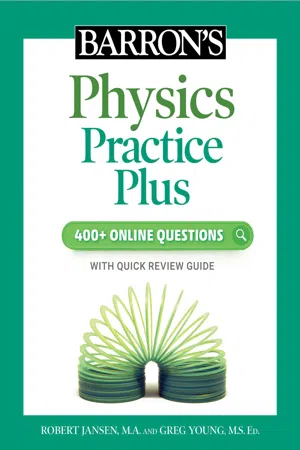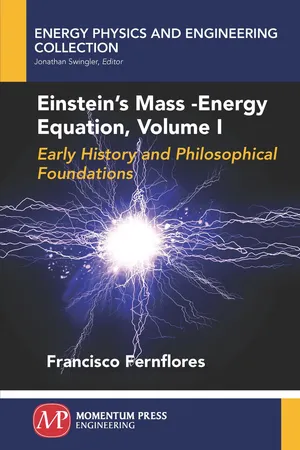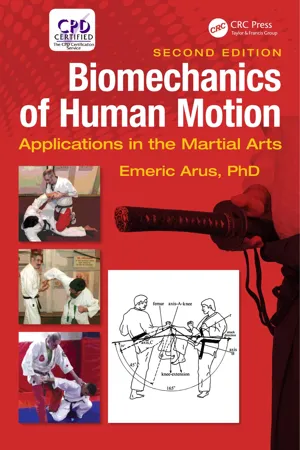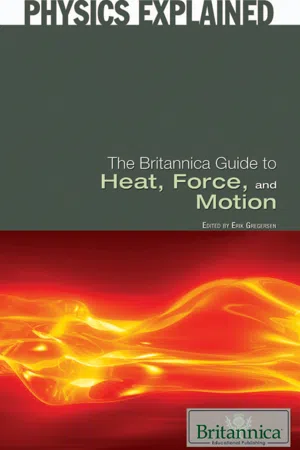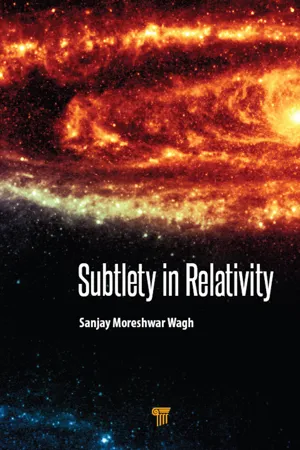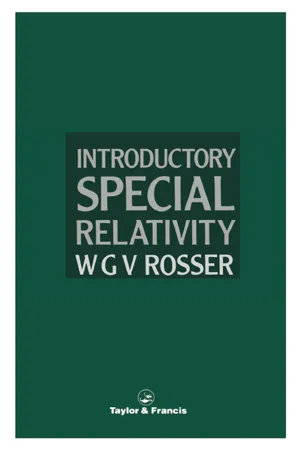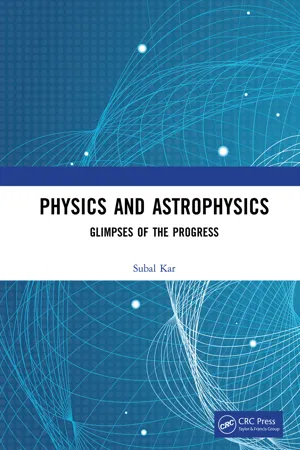Physics
Inertia
Inertia is the tendency of an object to resist changes in its state of motion. It is a fundamental property of matter and is related to an object's mass. Objects at rest tend to stay at rest, and objects in motion tend to stay in motion, unless acted upon by an external force.
Written by Perlego with AI-assistance
Related key terms
Related key terms
1 of 4
Related key terms
1 of 3
10 Key excerpts on "Inertia"
- Robert Jansen, Greg Young(Authors)
- 2022(Publication Date)
- Barrons Educational Services(Publisher)
CHAPTER 5 DynamicsLearning Objectives In this chapter, you will learn:∘ Why objects with mass possess Inertia and their natural state of motion is constant velocity∘ Why a force is a vector quantity that can be thought of as a push or a pull acting to change the motion of an object∘ The three laws of motion postulated by Sir Isaac Newton summarizing the interactions among objects, forces, and motion∘ How their influence on kinematics will be encountered in all areas of physics, developing universal problem-solving strategies for all dynamics problems, an essential skillTable 5.1 lists the variables used in dynamics.TABLE 5.1 Variables and Units for Forces in One DimensionInertiaInertia is the tendency of an object to resist changes in its natural motion. Galileo suggested that the natural state of motion of an object is constant velocity. Even an object at rest has a constant velocity of zero. Inertia is the tendency of a stationary object to remain at rest and for a moving object to continue moving at constant velocity. Inertia is a property of mass. The greater the mass of an object, the greater the Inertia possessed by the object. Simply put, the more mass the object has, the harder it is to push around the object. Physicists regard mass as a quantity of Inertia and a resistance to change in motion.ForceAn object cannot simply accelerate and change velocity on its own. In order to accelerate, an object must be pushed or pulled by some external source known as an agent. The push or pull of an agent that accelerates an object is known as a force. Forces are vector quantities measured in newtons.Since forces are vector quantities, they can be added together to find a resultant sum. The sum of all forces, , acting on an object is known as the net force. The direction of the net force is the same as the direction of the acceleration (change in velocity) of the object. The relationship between the direction of force and the direction of initial velocity of an object dictates the resulting change in motion, as shown in Table 5.2- eBook - ePub
- Francisco Fernflores(Author)
- 2017(Publication Date)
- Momentum Press(Publisher)
3 , p. 59].In the two corollaries to Definition 11, Euler explains that Inertia is the cause of a body remaining in its state of motion and “another cause besides the Inertia of this body cannot be assigned” [3 , p. 60].Philosophically, one feels the strength of Euler’s convictions concerning Inertia as the singular cause of a body persisting in its state is unsupported by the purported conceptual clarity actually delivered by the definition of Inertia and its attending corollaries and scholium. If, in a metaphysical mood, we ask “What is Inertia?”, Euler’s definition leaves us wanting, for it only tells us Inertia is an unknown property of objects that results in them persisting in a uniform state of motion (including the state of rest). Euler also tells us, it is true, that Inertia is the only cause of bodies persisting in a state of uniform motion, though we are left wondering why this must be so.However, there is a more refined way to approach Euler’s definition of Inertia. The term “Inertia” functions, in Euler’s Theoria , as a placeholder for whatever it is in physical bodies that leads them to exhibit the idealized behavior described in Euler’s three axioms. While we do observe objects at rest remaining at rest unless acted upon by a net impressed force, we tend not to witness directly terrestrial objects moving with a constant nonzero velocity. If the term “Inertia” merely functioned as a name for that unknown, hypothetical property of objects, one could argue that merely having a name for that unknown property does not increase our understanding very much. Yet, there are two reasons why Euler’s careful treatment of Inertia goes beyond merely the selection of a name.First, Euler improves our conceptual clarity of the foundations of mechanics by introducing the term “Inertia” as the single name for the unknown property of objects to persist in the same state of motion. Significantly, in the scholium to Definition 11, Euler states that we should reserve the term “force” for causes that change the state of a body. Consequently, since Inertia is not what changes the state of a body but instead causes it to persist in its state of uniform motion, Euler recommends that we stop using the phrase “force of Inertia” or “vis Inertiae ” as it engenders confusion [8 - eBook - ePub
Biomechanics of Human Motion
Applications in the Martial Arts, Second Edition
- Emeric Arus, Ph.D.(Authors)
- 2017(Publication Date)
- CRC Press(Publisher)
8Kinetics in Linear Motion
8.1 Inertia, MASS, WEIGHT, AND FORCE
The four words Inertia, mass, weight, and force are very closely related to each other. Inertia is the property of mass that causes it to resist any change in its motion or its state of stillness. Thus, a body at rest remains at rest unless it is acted upon by an external force and the body in motion continues to move at constant speed in a straight line unless acted upon by an external force. This statement represents Newton’s first law of motion.The mass is a measure of a body’s Inertia, that is, its resistance to acceleration. The mass of an object is constant everywhere. The weight is a force of attraction exerted on an object by the gravitational pull of the Earth. Weight on Earth has different values depending on the place where the object is. Being a force, weight should be measured in Newton (N), and a body of mass will have a weight = m ⋅ g , where ( g ) is the acceleration of free fall or gravity (9.80665 m/s2 ). The kilogram (kg) is an SI base unit of mass. From here results that a mass of 1 kg = 9.8 m/s2 . A man of 70 kg mass × 9.8 m/s2 will have 686 Newton force.8.2 FORCES
Recall that kinetics deal with motion that includes the forces that cause the motion. The physical property of the force , perhaps, is the most important between other physical properties, such as momentum, impulse, energy, velocity, and so on, which are related to objects in static positions or dynamic motions, including humans and animals alike. Force is described as the effect one object has on another, which can alter the state of a matter by pushing, pulling, twisting, sliding, and so on, and this effect of the force (F ) is the product of a mass and its acceleration F = m ⋅ a. - eBook - ePub
- Britannica Educational Publishing, Erik Gregersen(Authors)
- 2010(Publication Date)
- Britannica Educational Publishing(Publisher)
For Galileo, the principle of Inertia was fundamental to his central scientific task: he had to explain how it is possible that if Earth is really spinning on its axis and orbiting the Sun we do not sense that motion. The principle of Inertia helps to provide the answer: Since we are in motion together with Earth, and our natural tendency is to retain that motion, Earth appears to us to be at rest. Thus, the principle of Inertia, far from being a statement of the obvious, was once a central issue of scientific contention. By the time Newton had sorted out all the details, it was possible to account accurately for the small deviations from this picture caused by the fact that the motion of Earth’s surface is not uniform motion in a straight line. In the Newtonian formulation, the common observation that bodies that are not pushed tend to come to rest is attributed to the fact that they have unbalanced forces acting on them, such as friction and air resistance.As has already been stated, a body in motion may be said to have momentum equal to the product of its mass and its velocity. It also has a kind of energy that is due entirely to its motion, called kinetic energy. The kinetic energy of a body of mass m in motion with velocity ν is given byFALLING BODIES AND UNIFORMLY ACCELERATED MOTIONDuring the 14th century, the French scholar Nicole Oresme studied the mathematical properties of uniformly accelerated motion. He had little interest in whether that kind of motion could be observed in the realm of actual human existence, but he did discover that, if a particle is uniformly accelerated, its speed increases in direct proportion to time, and the distance it traverses is proportional to the square of the time spent accelerating. Two centuries later, Galileo repeated these same mathematical discoveries (perhaps independently) and, just as important, determined that this kind of motion is actually executed by balls rolling down inclined planes. As the incline of the plane increases, the acceleration increases, but the motion continues to be uniformly accelerated. From this observation, Galileo deduced that a body falling freely in the vertical direction would also have uniform acceleration. Even more remarkably, he demonstrated that, in the absence of air resistance, all bodies would fall with the same constant acceleration regardless of their mass. If the constant acceleration of any body dropped near the surface of Earth is expressed as g , the behaviour of a body dropped from rest at height z 0 and time t - eBook - ePub
- Emile Meyerson(Author)
- 2013(Publication Date)
- Routledge(Publisher)
a priori), Inertia, on the contrary, is a conception which offends our intelligence.The principle of Inertia stipulates the maintenance of rectilinear velocity. Velocity is the space covered in the unit of time, or, to express it more clearly, it is the quotient of the space covered by the elapsed time, both being measured by arbitrary units: .These definitions are exact on condition always that we remember that the terms time and space are here taken in a particular sense. Space means a path—that is, the length of a line limited by two points, and time, space of time—that is, duration equally included between two precise limits. That is the natural conception, alone conformable to our immediate experience. And we see to what a degree it is paradoxical to stipulate that velocity, a derived notion, abstract, deduced with the help of that of limit, shall persist beyond every limit. There is something there, doubtless, which shocks our understanding. Motion in its original sense means displacement; until Galileo and Descartes it had always been understood in this way. Aristotle assimilated it to change. In the most recent and most advanced theories of dynamic chemistry, those connected with the work of Gibbs, we may see that we are in the process of returning partially to these doctrines. But change operates between limits; also motion, when it takes place in a straight line, has always been conceived as directed toward a goal. “There is no change which is eternal,” says Aristotle, speaking of motion, “because naturally every change goes from a certain state to a certain state; and by a necessary consequence, every change has for a limit the contraries between which it occurs.”(84 ) “Impulsion is only motion proceeding from the impeller itself, or from another, and going toward another.”(85 - eBook - ePub
- Sanjay Moreshwar Wagh(Author)
- 2017(Publication Date)
- Jenny Stanford Publishing(Publisher)
Both Newton and Galileo had no reason to consider bodies of vanishing Inertia, for they imagined nonzero Inertia to be an intrinsic physical property of every natural body. But if a body has zero Inertia, then Newton’s laws of motion are not usable for it. Thus, interactions of Inertialess bodies among themselves and with bodies having Inertia cannot be analyzed using Newton’s laws of motion. That is to say, light does not obey Newton’s laws of motion if a light body has zero mass.The concept of gravitational mass is an artifact of, that is, it arises out of, the assumption of the action-at-a-distance character for the force. However, no observation or experimental result compels us to assume such a character for the force. The concept of the gravitational mass of the body is therefore not to be considered as a fundamental physical concept.The concept of Inertia of a body is not based on any assumptions, but it is a deduction from Galileo’s experiments. Therefore, in contrast to the notion of the gravitational mass of a body, its Inertia is a fundamental physical concept.Inertia was imagined by both Galileo and Newton as an intrinsic attribute of a physical body. But can we understand the origins of Inertia? Below is such a thinkable possibility.Imagine a crowded place. Let everyone of the crowd be at rest, initially at time t = 0. Now, introduce within this crowd a person A with nonzero velocity. Person A will collide with the nearest one in its path, and that will change the momenta of them both when the two are in contact. In this manner, changes to motion(s) take place. The directions and magnitudes of momentum (mass times velocity) of person A change, while he or she heads in a specific direction on the average.The motion of the person A is then resisted by persons who come into contact with person A. Effectively, we may then think of one force that is an average of all the contact forces encountered by person A. Similarly, we may also effectively think of an acceleration being the average of all accelerations of person A. Then, a proportionality factor of the force and the acceleration is the Inertia of the person. Denoting Inertia by m, we may, as Newton’s second law of motion, writeF →= ma → - eBook - ePub
- W G V Rosser(Author)
- 2017(Publication Date)
- CRC Press(Publisher)
It is all too easy in a first course on Newtonian mechanics to go on to the applications of Newton’s laws of motion, without fully appreciating the definitions and interpretations of the quantities, such as mass and force, that appear in the theory. Before discussing the changes in the laws of mechanics that are necessitated by the theory of special relativity, we shall give a brief survey of the interpretation of Newtonian mechanics. It will be assumed that the reader has already had a course on mechanics leading up to Newton’s laws of motion, which will be taken as our starting point. Newton’s laws of motion are as follows.(i) Every body continues in its state of rest or of uniform motion in a straight line unless it is compelled to change that state by an external impressed force. (ii) The rate of change of momentum is proportional to the impressed force, and takes place in the direction of the force.(iii) Action and reaction are equal and opposite. That is, between two bodies the force exerted by one on the other is equal in magnitude to the force it experiences from the other and in the opposite direction.These laws were developed and have been applied to describe the mechanical behaviour of macroscopic bodies, such as the orbits of the planets and the collisions of billiard balls, all moving at speeds very much less than the speed of light in empty space, which is c = 2.99792 × 108 m s−1 (we shall generally use the approximate value of c ≈ 3 × 108 m s−1 in our calculations). The speed of an aeroplane going at 3000 km h−1 is less than 3 × 10−6 c. It will be shown in Chapters 2 and 6 that when the speeds of particles are comparable to that of light, Newtonian mechanics must be replaced by relativistic mechanics. The only particles that can be accelerated to speeds close to the speed of light in the laboratory are atomic particles, such as protons and electrons—so that small size generally goes with high speed. This is well outside the range of our everyday experiences, and special relativity should be approached in Chapter 4 with an open mind, with the realization that it will require the development of new concepts on the part of the reader.1.2.2 Newton’s first law and Inertial reference framesThe question arises as to how one can select a coordinate system in which Newton’s laws of motion are valid. If in a reference frame a particle under the influence of no forces (e.g. a particle far away from any other particles capable of exerting forces) travels in a straight line with constant speed then Newton’s first law (the principle of Inertia) is valid in that frame, which is then considered suitable for the application of Newton’s laws of motion. Such a reference frame is called an Inertial reference frame, or Inertial frame or sometimes a Galilean reference frame. An experimenter at rest in an Inertial reference frame is called an Inertial observer. The same definition of an Inertial reference frame will be used in the theory of special relativity. Owing to the rotation of the Earth, the laboratory frame, that is a reference frame fixed to the Earth, is strictly not an Inertial reference frame, and effects associated with the Earth’s rotation are sometimes important. For example, consider a spaceship coasting with uniform velocity relative to the fixed stars. There are no applied forces acting on the spaceship. If its position is plotted on a coordinate system fixed to the Earth then, owing to the Earth’s rotation, the spaceship will appear to travel in a spiral path, going around through 360° every day. According to Newton’s first law, since there are no forces acting on the spaceship, it should travel in a straight line in all Inertial reference frames. This shows that the laboratory frame, i.e. a reference frame fixed to the Earth, is not an Inertial reference frame, and effects associated with the Earth’s rotation are sometimes important even in terrestrial experiments, such as long-range naval gunnery and Foucault’s pendulum experiment. In these cases we get a better approximation to an Inertial reference frame by taking a frame at rest relative to the solar system or the fixed stars. However, the angular velocity of rotation of the Earth is only 7.3 × 10−5 rad s−1 - eBook - ePub
- Max Born(Author)
- 2012(Publication Date)
- Dover Publications(Publisher)
Ancient thinkers were much troubled in trying to discover what forces actually maintain the motion of the thrown stone. Galileo was the first to take the right point of view. He observed that it is a fallacy to assume that wherever there is motion there must always be force. Rather it must be asked what quantitative property of motion is in a regular fixed relation to force, whether it be the position of the moving body, its velocity, its acceleration, or some composite quantity dependent on all of these. No amount of reflection will allow us to derive an answer from philosophy. We must address ourselves directly to nature. The answer which she gives is that force has an influence in effecting changes of velocity but that no force is necessary to maintain a motion in which the magnitude and the direction of the velocity remain unaltered. And conversely, where there are no forces, the magnitude and direction of the velocity remain unaltered; thus a body which is at rest remains at rest, and one that is moving uniformly and rectilinearly continues to move uniformly and rectilinearly. This law of Inertia (or persistence) is by no means so obvious as its simple expression might lead us to surmise. In our experience we do not know of bodies that are really withdrawn from all external influences; and, if we use our imaginations to picture how they travel in their solitary rectilinear paths with constant velocity through astronomic space, we are at once confronted with the problem of the absolutely straight path in space absolutely at rest, with which we shall have to deal later. For the present, we shall interpret the law of Inertia in the restricted sense in which Galileo meant it. Let us consider a smooth, exactly horizontal table on which a smooth sphere is resting. This is kept pressed against the table by its own weight - eBook - ePub
Physics and Astrophysics
Glimpses of the Progress
- Subal Kar(Author)
- 2022(Publication Date)
- CRC Press(Publisher)
Like most breakthroughs in physics, Newton's laws of motion not only addressed the questions relating to the motion of bodies around us but also empowered human minds to realize that the laws of physics applicable in our Earth are equally applicable for the so-called heavenly bodies. His universal law of gravitation could satisfactorily answer a childish, yet serious, question of the day: Why does the Moon above the sky not fall to Earth just like a huge, dropped rock? Prior to Newton, the idea was that this happens because the laws of Heaven are different from those of our human Earth! Newtonian physics concerning the laws of motion and gravity not only set forth a revolution in the scientific thought of the day, but his concept spread like wildfire and was gradually applied to other topics of physics such as light, gases, liquids, solids, electricity, and magnetism. His concepts were extrapolated not only to the macrocosms of space, but also to the microcosms, finding that many properties of gases and other substances could be explained by applying Newton's laws of motion to the atoms they are made of. This scientific revolution ushered in the Industrial Revolution in the 18th century and ultimately led to modern-day space exploration and the information boom. Newton's law of gravitation can explain the cause of the tides, predict the occurrence of eclipses, simulate the launching of rockets from Mars to Neptune (and even today in making interstellar journey by Voyager II), and figure out when and how the spaceship will arrive at the desired destination. In this section, we discuss Newton's laws of motion and the universal law of gravitation.1.4.2 Newton's Laws of Motion
Newton's first law of motion (also known as the law of Inertia) is concerned with the Inertia of rest and the Inertia of motion of a body. It states that a body at rest or in uniform motion would continue to remain in that particular state unless otherwise it is acted upon by a net external force (i.e., an unbalanced force). A little elucidation will make the point clear. A body in uniform motion tends to continue at that state of motion until an opposing force reduces its velocity or brings it to rest. We observe this process when we apply the brakes to our moving car, which increases the frictional force between the wheel tire and the surface of the road to oppose the motion of the car. To accelerate - eBook - ePub
Doing Physics with Scientific Notebook
A Problem Solving Approach
- Joseph Gallant(Author)
- 2012(Publication Date)
- Wiley(Publisher)
Chapter 5Newton’s Laws of Motion
In the previous chapters on kinematics, we described motion in a quantitative sense. Once we know an object’s acceleration, we can describe its motion in terms of position, velocity, and time. Knowing how its motion changes lets us calculate how far, how fast, and how long the object moves.Now we move to a branch of physics known as dynamics. Dynamics is the study of the effects of forces on an object’s motion. Dynamics explains changes in motion by relating the cause of the changes (forces) to the effect (acceleration). Newton’s Second Law provides the rule relating the acceleration to the net force.There are three ingredients to Newton’s Second Law: the object’s acceleration, mass, and the net force acting on it. As we discussed in Chapter 2, the object’s acceleration is the rate of change in its velocity. Mass is a property of the object that determines how much change the net force produces. An object’s mass tells you how difficult it is to change its velocity and how much matter it has.A force is a push or a pull that can cause changes in motion. Forces are vectors, so they have magnitude and direction. This is consistent with your experience. When you exert a force on something, two things matter: how hard you push or pull and which way. Often objects have more than one force acting on them. The net force acting on an object is the vector sum of all the forces acting on it.Newton’s First Law
Newton’s First Law tells us what happens when there is no net force acting on an object.Newton’s 1st Law: An object will remain in a state of rest or continue in motion at a constant velocity unless compelled to change by a non-zero net force.When there is no net force acting on the object, there is no change in the object’s velocity. If it is at rest, it remains at rest. If it is moving, it keeps moving at constant velocity. Since velocity is a vector, constant velocity means no change in both speed and direction. Motion at constant velocity is motion in a straight line at a constant speed.
Index pages curate the most relevant extracts from our library of academic textbooks. They’ve been created using an in-house natural language model (NLM), each adding context and meaning to key research topics.
Explore more topic indexes
Explore more topic indexes
1 of 6
Explore more topic indexes
1 of 4
